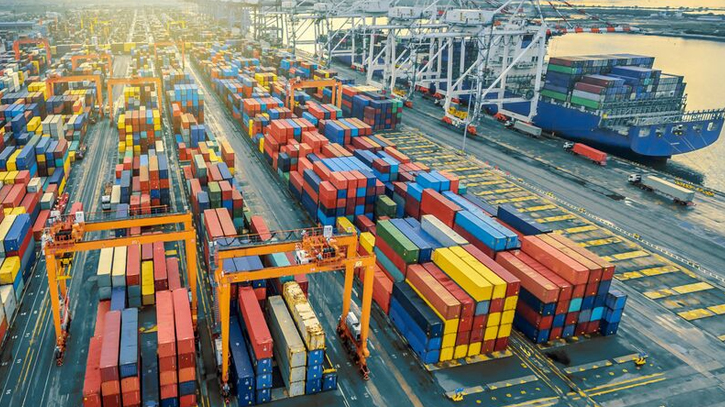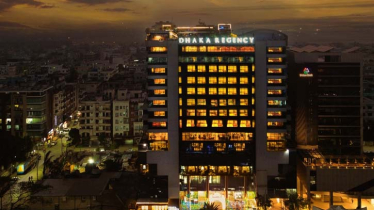
Photo: Collected
Due to global complications, Bangladesh is facing a container crisis in shipping export goods. Shipping lines are unable to deliver empty 40-foot containers even with the payment of extra fares. As a result, exporters are bound to use airways, which is highly expensive.
Thousands of containers along with ships are stuck in various Asian ports, including Singapore and Colombo, due to the deadlock in the Middle East ports in the face of attacks by Houthi rebels in the Red Sea. In this situation, Bangladesh’s garment exporters are facing a challenge in sending export products to Europe and America.
Although exports from Bangladesh to Europe and America are high, the country's garment traders are in trouble due to the lack of empty containers. Fazlee Shamim Ehsan, vice president of Bangladesh Knitwear Manufacturers and Exporters Association (BKMEA), told The Daily Messenger, “We are forced to ship goods by air to save time due to the container crisis, which is very expensive. Roughly speaking, we have to spend one-year profit to send just an item by air. It’s equal to cancelling the consignment.”
“The Singapore route, which Bangladeshi exporters use the most, has mainly been affected by the Red Sea crisis. There is a huge congestion on the route. Currently, we need 50-60 days to ship goods, which earlier was 15-20 days. Besides, buyers do not bear the extra shipment costs,” he said.
For more than eight months, Houthi rebels have been attacking Jewish-owned ships in the Red Sea. In this situation, because the ships going to Europe and America have changed their routes, the number of ships in the ports in nearby areas, including the United Arab Emirates, Qatar, Oman, and Saudi Arabia, has decreased a lot. As an alternative transshipment port, the pressure has increased on the Asia-based ports in Singapore, Sri Lanka, and Malaysia.
Mohammad Ajmir Hossain Chowdhury, deputy general manager at Mediterranean Shipping Company (MSC), told The Daily Messenger, “Ports in the Middle East, which used to be transshipment hubs, have seen a significant reduction in ship traffic. That pressure is now on the ports in Asia.”
According to information from shipping officials, ships going to Europe and America could earlier berth in Singapore or Asian transshipment ports without any delay. At present, it takes three to seven days for each ship to berth. In this situation, the movement of empty containers around the world has decreased a lot. As a result, there is a shortage of containers for shipping export goods from Bangladesh.
Syed Mohammad Arif, chairman of Bangladesh Shipping Agents’ Association, said container fares have increased due to changes in routes. “Besides, ships take more time for berthing. This has created a container crisis for shipping goods.”
The country's garment traders are in extreme trouble. In the last one month, the fare of each 40-foot container bound for Europe and America increased from $500 to $1,500. Mohammad Hatem, vice president of BKMEA, said, “Though industrialisation progress is very slow, foreign investment is currently increasing in the country’s 100 economic zones. So, our ports will have to be more efficient and maintain international standards.”
Some 70,000 empty containers are needed every month to send export products from Bangladesh to different ports. At least 65,000 containers are 40 feet in size.
Bangladesh used to be a dumping station for empty containers even a few months ago due to relatively low charges. But now the demand for empty containers to ship export goods is increasing globally. Amid this, the world-famous companies are failing to supply containers. There is no alternative to quickly supplying empty containers to keep Bangladesh's export trade running, experts said.
“The Chittagong seaport is referred to as the golden gate of prosperity. This is because about 92 per cent of the import-export trade takes place through this port. In particular, almost 100 per cent of container goods pass through this port, but activities have declined sharply at present,” Md Ruhul Amin Sikder, secretary at Bangladesh Inland Container Depots Association (BICDA), told The Daily Messenger.
Business leaders demand the expansion of the port and also a new deep seaport. To this end, various initiatives are being taken and implemented to expand the port and increase productivity.
Garment is the main export product that earns Bangladesh the highest amount of foreign currency. But that declined for the first five months of this year due to the global crisis. According to Bangladesh Garment Manufacturers and Exporters Association (BGMEA), apparel exports were $4.97 billion in January, $4.49 billion in February, $4.34 billion in March, $3.29 billion in April, and $3.35 billion in May.
In May, export growth was down by 17.19 per cent year on year. Besides, in the first five months of 2024, apparel exports grew very insignificantly by 2.86 per cent.
Messenger/Disha








